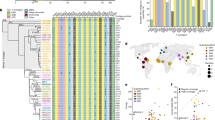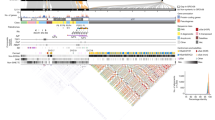Abstract
The strong suppression of crossing-over between the X and Y chromosomes permits rapid accumulation of repetitive sequences in the Y chromosome. To gain insight into the mechanism responsible for the sequence amplification, it is essential to characterize Y chromosomal repetitive sequences at the molecular level. Here, we report the entire nucleotide sequence (3,902bp) of AC11, a mouse sequence that is repeated 300 times in the Y chromosome. AC11 is AT rich (32.8% GC), and contains many short poly(A) sequences. In addition, it has Bkm and LINE sequences as well as a Y chromosome-specific sequence. The Bkm sequence consists of typical (GATA) and (GACA) repeating units, whereas the LINE sequence deviates considerably from other mouse LINE sequences (71–76% identity) and may be considered atypical. The Y chromosome-specific region seems to be unique and does not identify similar sequences in the GenBank library. The information obtained from the nucleotide sequence should form the foundation to study the evolutionary processes through which AC11-related sequences have accumulated in the mouse Y chromosome.
Similar content being viewed by others
References
Biddle, F.G., B.A., Eales & Y., Nishioka, 1991. A DNA polymorphism from five inbred strains of the mouse identifies a functional class of domesticus Y chromosome that produces the same phenotypic distribution of gonadal hermaphrodites. Genome 34: 96–104.
Biddle, F.G. & Y., Nishioka, 1988. Assays of testis development in the mouse distinguish three classes of domesticus-type Y chromosome. Genome 30: 870–878.
Bishop, C.E., P., Boursot, B., Barron, F., Bonhomme & D., Hatat, 1985. Most classical Mus musculus domesticus laboratory mouse strains carry a Mus musculus musculus Y chromosome. Nature 315: 70–72.
Charlesworth, B., 1991. The evolution of sex chromosomes. Science 251: 1030–1033.
Dubnick, M., J., Chou, T.D., Peter & R.A., Farber, 1983. Relationships among DNA sequences of the 1.3 kb EcoRI family of mouse DNA. J. Mol. Evol. 19: 115–121.
Eicher, E.M., K.W., Hutchison, S.J., Phillips, P.K., Tucker & B., Lee, 1989. A repeated segment on the mouse Y chromosome is composed of retroviral-related, Y-enriched and Y-specific sequences. Genetics 122: 181–192.
Epplen, J.T., A., Cellini, S., Romero & S., Ohno, 1983. An attempt to approach the molecular mechanisms of primary sex determination. W- and Y-chromosomal conserved simple repetitive DNA sequences and their differential expression in mRNA. J. Exp. Zool. 228: 305–312.
Epplen, J.T., J.R., McCarrey, S., Sutou & S., Ohno, 1982. Base sequence of a cloned snake. W-chromosome DNA fragment and identification of a male-specific putative mRNA in the mouse. Proc. Natl. Acad. Sci. U.S.A. 79: 3798–3802.
Fanning, T.G., 1983. Size and structure of a highly repetitive BAM HI element in mice. Nuc. Acids Res. 11: 5073–5091.
Jones, K.W. & L., Singh, 1981. Conserved repeated DNA sequences in vertebrate sex chromosomes. Human Genet. 58: 46–53.
Krayev, A.S., D.A., Kramerov, K.G., Skryabin, A.P., Ryskov, A.A., Bayer & G.P., Georgiev, 1980. The nucleotide sequence of the ubiquitous repetitive DNA sequence B1 complementary to the most abundant class of mouse fold-back RNA. Nuc. Acids Res. 8: 1201–1215.
Lamar, E.E. & E., Palmer, 1984. Y-enriched, species-specific DNA in mice: Evidence that the Y chromosome exists in two polymorphic forms in inbred strains. Cell 37: 171–177.
Loeb, D.D., R.W., Padgett, S.C., Hardies, W.R., Shehee, M.B., Comer, M.H., Edgell & C.A., Hutchison, 1986. The sequence of a large L1Md element reveals a tandemly repeated 5′ end and several features found in retrotransposons. Mol. Cell. Biol. 6: 168–182.
Meunier-Rotival, M. & G., Bernardi, 1984. The Bam repeats of the mouse genome belong in several superfamilies the longest of which is over 9 kb in size. Nuc. Acids Res. 12: 1593–1608.
Nallaseth, F.-S. & M.J., Dewey, 1986. Moderately repeated mouse Y chromosomal sequence families present distinct types of organization and evolutionary change. Nuc. Acids Res. 14: 5295–5307.
Nallaseth, F.-S., R.P., Lawther, M.R., Stallup & M.J., Dewey, 1983. Isolation of recombinant bacteriophage containing male specific mouse DNA. Mol. Gen. Genet. 190: 80–84.
Nishioka, Y., 1987. Y-chromosomal DNA polymorphism in mouse inbred strains. Genet. Res. 50: 69–72.
Nishioka, Y., 1988a. Application of Y chromosomal repetitive sequences to sexing mouse embryos. Teratology 38: 181–185.
Nishioka, Y., 1988b. Evolutionary characterization of a Y chromosomal sequence conserved in the genus Mus. Genet. Res. 52: 145–150.
Nishioka, Y., 1989. Genome comparison in the genus Mus: a study with B1, MIF (mouse interspersed fragment), centromeric and Y-chromosomal repetitive sequences. Cytogent: Cell Genet. 50: 195–200.
Nishioka, Y. & E., Lamothe, 1986. Isolation and characterizatio of a mouse Y chromosomal repetitive sequence. Genetics 113: 417–432.
Nishioka, Y. & E., Lamothe, 1987a. Evolution of a mouse Y chromosomal sequence flanked by highly repetitive elements. Genome 29: 380–383.
Nishioka, Y. & E., Lamothe, 1987b. The Mus musculus musculus type Y chromosome predominates in Asian house mice. Genet. Res. 50: 195–198.
Sanger, F., S., Nicklen & A.R., Coulson, 1977. DNA sequencing with chain-terminating inhibitors. Proc. Natl. Acad. Sci. U.S.A. 74: 5463–5467.
Schäfer, R., E., Böltz, A., Becker, F., Bartlets & J.T., Epplen, 1986. The expression of the evolutionarily conserved GATA/GACA repeats in mouse tissues. Chromosoma 93: 496–501.
Singer, M.F., 1982. Highly repeated sequences in mammalian genomes. Int. Rev.Cytol. 76: 67–112.
Singh, L. & K., Jones, 1982. Sex reversal in the mouse (Mus musculus) is caused by a recurrent nonreciprocal crossover involving the X and an aberrant Y chromosome. Cell 28: 205–216.
Singh, L., C., Phillips & K.W., Jones, 1984. The conserved nucleotide sequences of Bkm, which define Sxr in the mouse, are transcribed. Cell 36: 111–120.
Singh, L., I.F., Purdom & K.W., Jones, 1980. Sex chromosome associated satellite DNA: evolution and conservation. Chromosoma 79: 137–157.
Taketo-Hosotani, T., Y., Nishioka, C.M., Nagamine, I., Villalpando & H., Merchant-Larios, 1989. Development and fertility of ovaries in the B6.YDOM sex-reversed female mouse. Development 107: 95–105.
Tucker, P.K., B.K., Lee & E.M., Eicher, 1989. Y chromosome evolution in the subgenus Mus (genus Mus). Genetics 122: 169–179.
Voliva, C.F., C.L., Jahn, M.B., Comer, M.H., Edgell & C.A., Hutchison, 1983. The L1Md long interspersed repeat family in the mouse: almost all examples are truncated at one end. Nucl. Acids Res. 11: 8847–8859.
Author information
Authors and Affiliations
Rights and permissions
About this article
Cite this article
Nishioka, Y., Dolan, B.M., Fiorellino, A. et al. Nucleotide sequence analysis of a mouse Y chromosomal DNA fragment containing Bkm and LINE elements. Genetica 87, 7–15 (1992). https://doi.org/10.1007/BF00128768
Received:
Accepted:
Issue Date:
DOI: https://doi.org/10.1007/BF00128768




